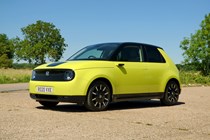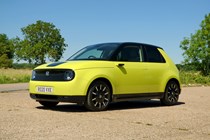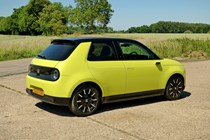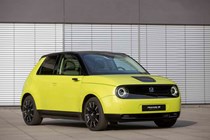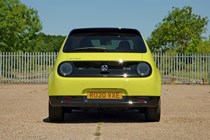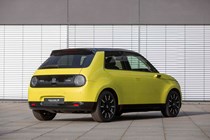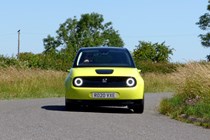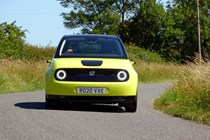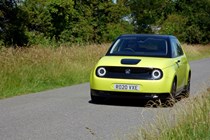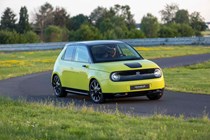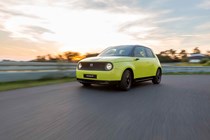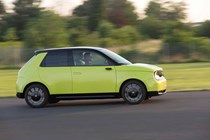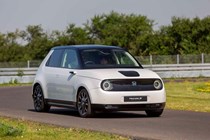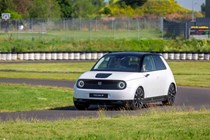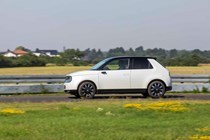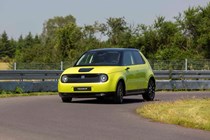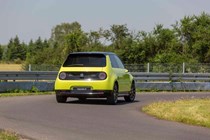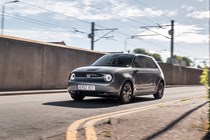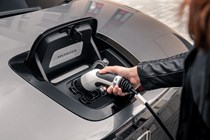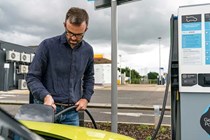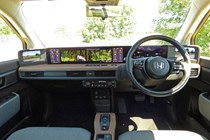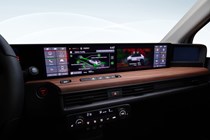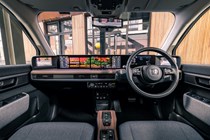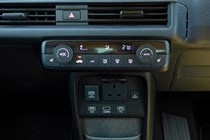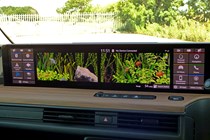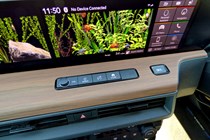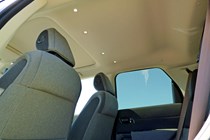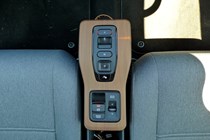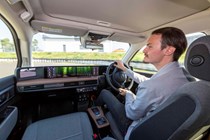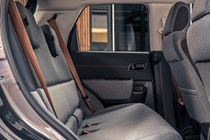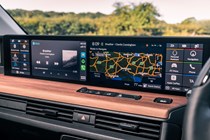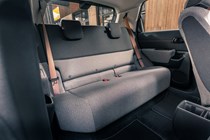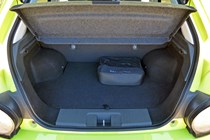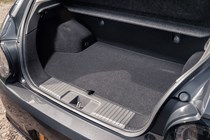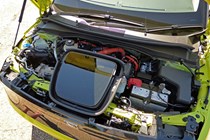
Honda e long-term test
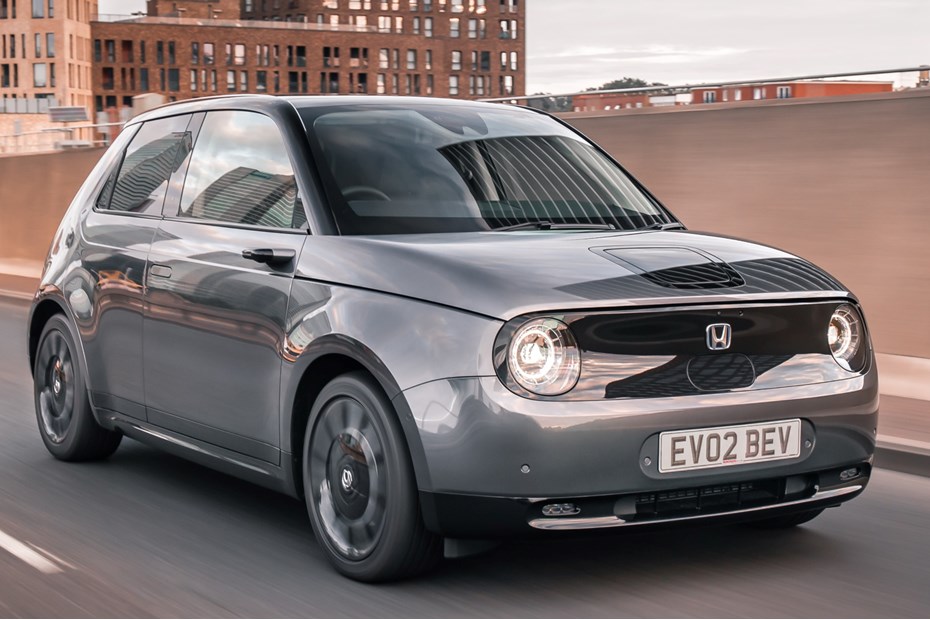
Update 1: Spending six months with a Honda e
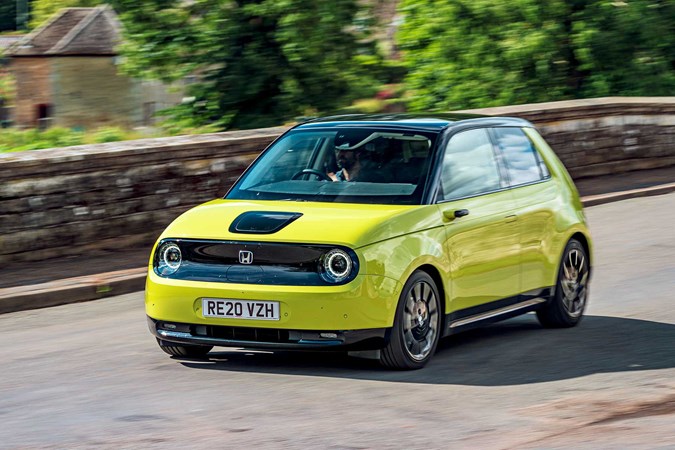
Welcoming the baby Honda e to the Parkers long-term test fleet: achingly cool but is there substance behind the trendy veneer?
Want proof that electric cars are becoming more interesting, smaller and cheaper by the month? Look no further than the latest Honda e – the Japanese brand’s first production electric vehicle (EV) in Europe. It’s one of the most head-turning cars to launch in 2020, and Parkers is living with one for half a year to find out what it’s really like.
Buyers have a terrifically simple choice when eyeing up a Honda e in the showroom. There are just two models available: the entry-level car (RRP £26,660) and this range-topping Advance model (£29,160). Those prices quoted are after the Government’s handy £3,000 Plug-in Car Grant, designed to incentivise people to consider pure EVs.
Electric cars: everything you need to know
Of course, most buyers finance their cars and don’t pay outright, and if you’re thinking that paying the thick end of 30 grand for a small city car is a lot of money, the monthly PCP price at a main dealer starts at a more reasonable £229 at the time of writing.
Our Honda e Advance comes in a most eye-grabbing Charge Yellow paint job that pings and zings and grabs eyeballs left, right and centre; this is one of the most unusual car designs for many a year and the cartoonish style looks like it could have leapt from the pages of a Japanese manga comic – or even (whisper it) from the Apple design studios of Cupertino. It’s that cool.
It’s a small car, stretching to just 3.9m long and it looks diminutive in the metal. Yet because it’s fully electric with a totally flat floorpan, there’s sufficient space inside for four adults and we’ll be testing the comfort and practicality in the months ahead. But even the first time you slide behind the wheel, it’s apparent the Honda e does things differently: the interior is wilfully unlike any other small car you’ll ever have experienced before.
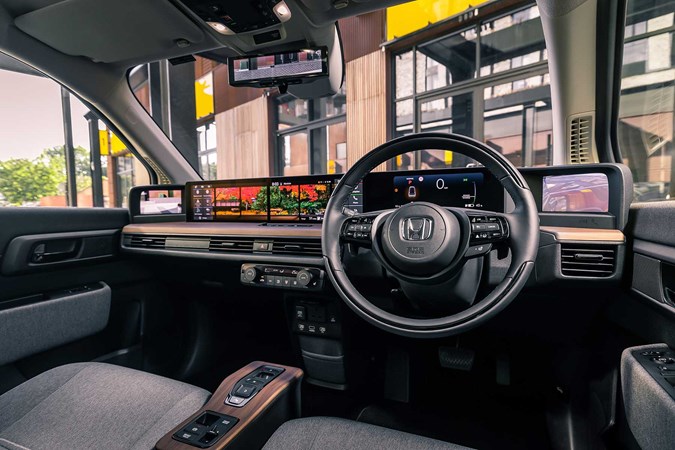
Gone are traditional dials and instruments, replaced by a full-width giant digital screen. Even the door mirrors are replaced by cameras, whose displays bookend the ultra-widescreen monitor in front of you. If you hate apps and digital ecosystems, you may want to walk away now. But so far, everything works just fine, the cameras are easy to adapt to and we love the purity of the Honda’s cabin.
All of these gizmos are standard. The Advance’s £2,500 premium over the entry-level model buys a clever switchable analogue/digital rear-view mirror (you can flip it between a normal mirror, or a digi screen which cleverly/disconcertingly ‘sees through’ rear-seat passengers’ heads), a heated steering wheel, three-point plug for charging small devices and a self-parking function that’ll spot spaces as you drive along and shuffle the wheel for you when manoeuvring.
We’ll be putting all that tech to the test in the coming weeks. Moreover, we’re about to find out if the Honda e has the electric creds to match its electrifying looks.

The quoted battery capacity is a compact 36kWh, meaning that Honda claims a tiny range of only 125 miles when fully charged. Its range is significantly shorter than that of its closest rivals, such as the Peugeot e-208 electric car (above).
Is it enough for daily duties? Will the Honda e be consigned to life as a city car, limited in appeal to those living in London or Liverpool? Or can it cope with the more mixed town-and-country driving that we’ll be subjecting it to this winter?
Stay tuned to our regular reports while we plug in to find out…
Update 2: Comfort and practicality
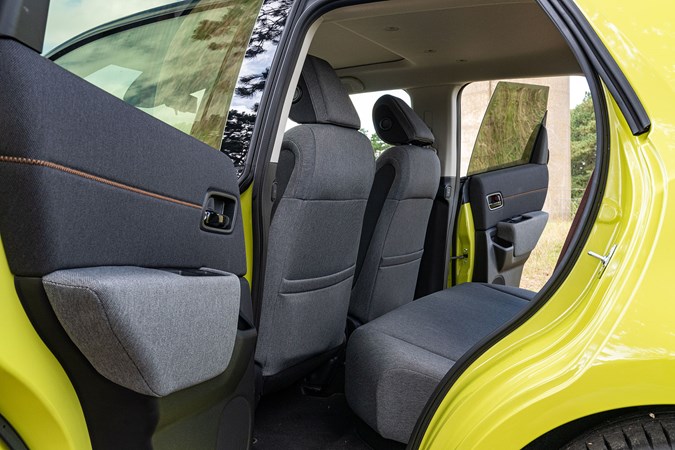
Honda’s electric city car may be small, but it’s fine for day-to-day chores and can fit four adults – just go easy on the luggage
The Honda e is a compact city car and at just 3894mm long it’s definitely on the small side. In fact, it’s comfortably shorter than a Ford Fiesta, so it’s impressive how much space they’ve magicked into the cabin. This is one of the forgotten benefits of an electric car, as the packaging is different from a petrol or diesel vehicle with their cumbersome engines and fuel tanks and transmission tunnels bisecting rear foot space.
Freed from the constraints of internal combustion, the Honda e has a totally flat floor front and rear, meaning there’s loads of room to plonk your feet and its tall, cartoonish design means that there’s fair space for your hairdo, too. It’s not quite Tardis-like, but it’s surprising how much room is in such a compact footprint and we love the wide, near perpendicular angle the doors open to. The pics above and below show how much easier it makes entry and exit.
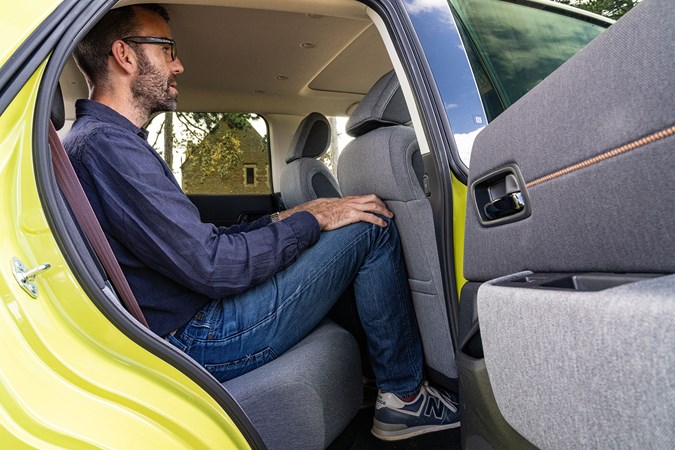
I’m 6ft 3in and can sit comfortably in the front and just about squeeze into the back seats for shorter journeys. Taller occupants will have to ask the front row nicely to push their seats forwards, but the photo above was taken with the seat in my usual driving position.
Verdict? You can use this small car as a four-seater every single day. Note there are only four seatbelts, though – there’s really not room for a fifth passenger in here.
It’s also worth bearing in mind that the rear seatback doesn’t split; you can only lower it in one piece, removing some of the flexibility that a split-fold system can provide. The e is either a four-seater or a two-seater, with no room to mix and match. You are likely to drop the rear seat quite frequently, since the boot is tiny.
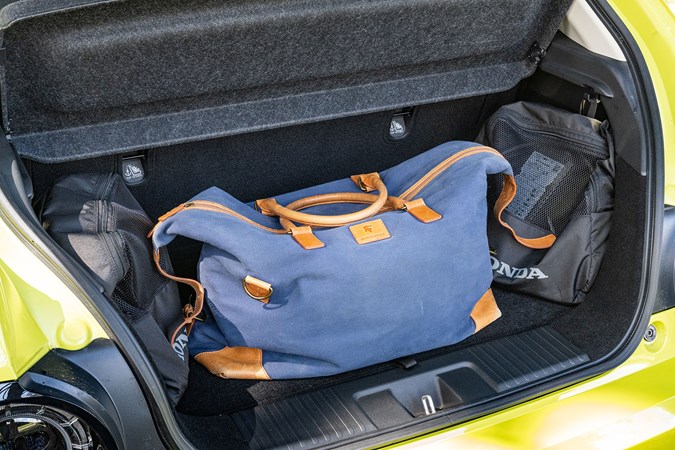
In fairness, the loadbay is on a par with that in close rival the MINI Electric, but the Honda’s is particularly high up and the dimensions are pretty bijou. One overnight bag, or even a laptop satchel and a couple of bags of shopping, will easily fill it up and we have got used to flopping the seatback forwards to accommodate larger items such as golf clubs and suchlike. Go into full van mode and we have actually squeezed in clobber for a trip to the dump and even a very long, telescopic hedgecutter. Who said small cars can’t be practical?
For more mundane day-to-day driving, the Honda is well thought through and full of useful touches. The trio of cupholders between the front seat can be configured to carry different items and my phones and keys are found here more often than a cappuccino. Drinks are gripped by a delightfully leather-handled pop-out cupholder that slides out from the central console, while other chattels are stowed in the generous glovebox or door pockets.
This is a resolutely modern city car and the number of plugs and ports it sports is impressive: there are two USB charging docks in the front and a pair for rear-seat passengers too, so all four occupants can keep their phones topped up; there’s an old-school 12-volt socket; and even a three-point domestic plug as standard, so you can charge up your laptop if you need to work when out and about.
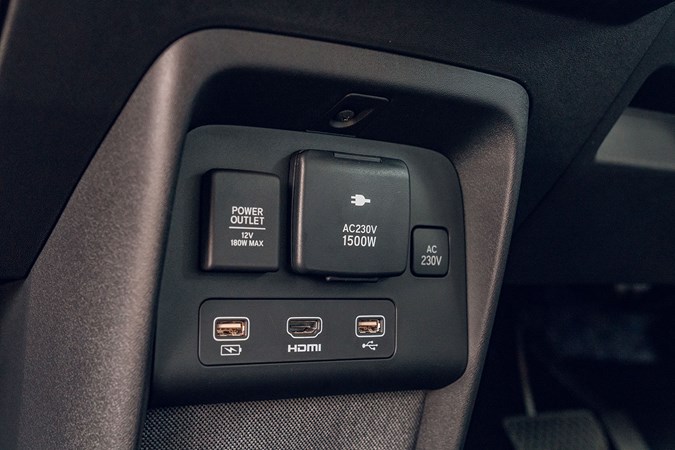
It’s reassuring to know I could plug in a computer or video player, should I be waiting at a motorway service station for a fast-charge of the EV’s 36kWh battery. Though the energy flow of that particular scenario does start to boggle your mind when you think about it!
Update 3: Ask us anything!
We asked you for your questions about our Honda e via the Parkers Twitter and Facebook pages – and here are our answers
Too much screen real estate?
— Christian Pratt (@crp_uk) November 20, 2020
Christian Pratt’s question is a common one: the Honda’s screen is VAST – but I’ve quickly got used to it. Traditionalists may find it too much, but the chances are that those interested in the e are by definition going to be digitally savvy. And they’ll be pleased with the Honda’s interior. The screens are easy to read, don’t reflect and keep grubby fingerprints at bay. They’ve really thought this through.
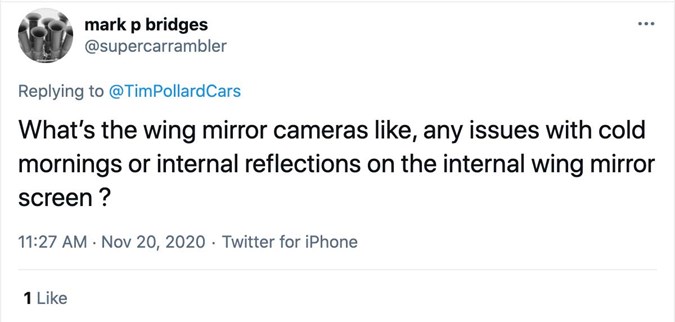
Mark Bridges asks about the cameras-for-door-mirrors. They are the best ones we’ve yet tried and work better than those in the Audi E-Tron in our experience. The aquaphobic coating keeps muck and rainwater off them in wet weather and the image by day is excellent: crisp, fast-moving and positioned instinctively where you’d expect to look. We’re less satisfied at nighttime, when the screens’ depiction of black is a little unnerving, if we’re honest.
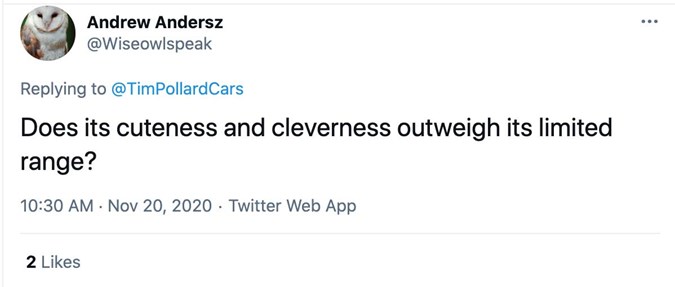
A great, pertinent question from Andrew Andersz. The paucity of EV range will restrict the appeal of the Honda e to many drivers. If you live in a city or just drive lots of short trips, then this small EV will slot right into your life. But that 36kWh battery does limit the usefulness to longer-distance drivers. If you regularly do more than 100 miles a day, we’d say it’s not really for you. If you’ve fallen head over in love with its cute styling, you’ll just have to accept the need to charge up frequently on the go.
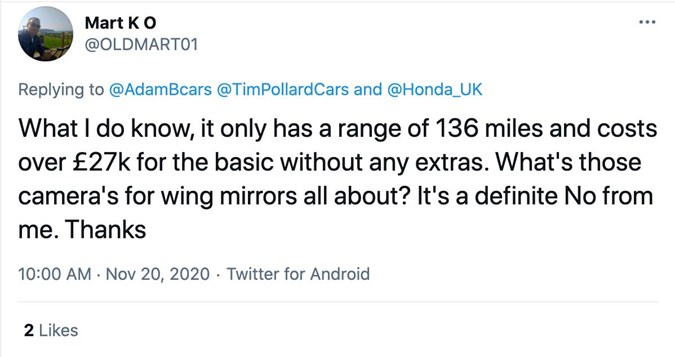
Mart is a little sceptical about the value and range offered by the Honda e – and we can fully understand that. It feels like an Apple electronics product: high-cost, high-cool, aching with desirability. But other buyers may prefer a more Android-like, cheaper approach to electric vehicles.
Update 4: Performance and handling
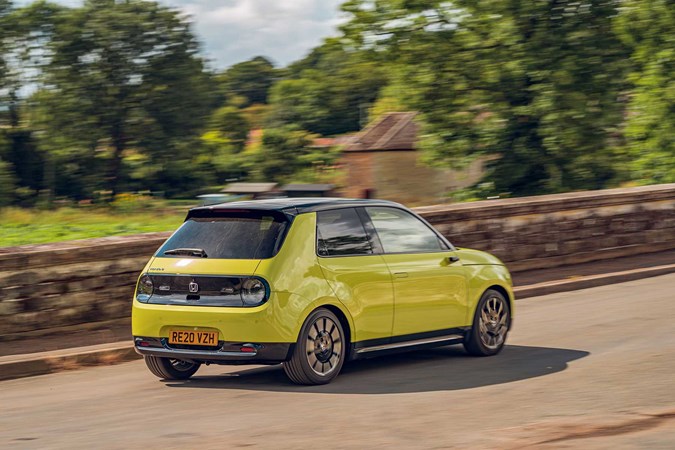
The Honda e is simple to adapt to, if you’re coming out of a line of petrol or diesel cars. It’s a really easy transition to make – and we’ve not found it daunting or complicated in the slightest
Like all electric cars, the baby Honda is automatic – so it’s really just a question of pressing the start button (it’s keyless, so you just leave the fob in your pocket or handbag), popping your foot on the brake pedal, selecting the Drive button and creeping forwards on battery power. The handbrake releases automatically.
It’s all remarkably normal.

Because it’s a single-speed transmission, there are no gears or clutch pedals to worry about and progress is smooth, quiet and serene. The Honda e emits a strange electronic whoosh at walking pace – to alert pedestrians that your silent EV is approaching – but once beyond 10mph or so, it’s totally hushed.
Electric cars enjoy rapid acceleration from their powerful e-motors and this is no different. It shoots away from traffic lights like a hot hatch, but performance tails away at higher speeds. This is not a problem: if you drive it aggressively and enjoy the slingshot acceleration too much, you’ll see the battery’s indicated range plummet in double-quick time.
Much better to adopt a more leisurely pace, keep up with the traffic and lift off early to harvest braking energy back into the battery.
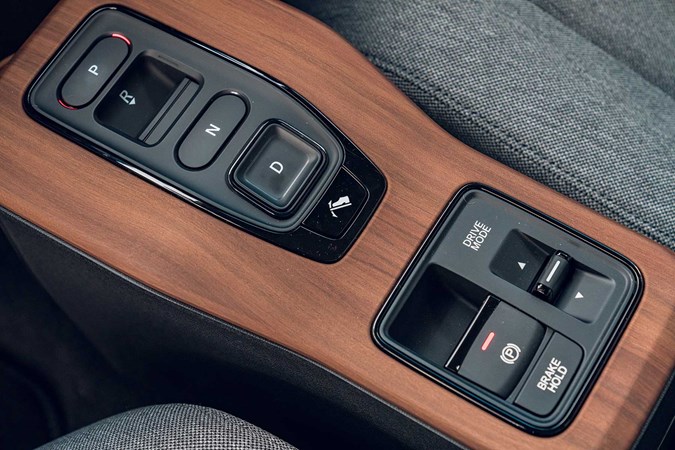
This is another EV trick: there is a button marked with a foot on the pedal, just behind the P, R, N, D gear selectors (above) and I press this on every journey to enable one-pedal driving.
It increases what’s called regenerative braking – the ability of an electric car to flip its e-motor into dynamo mode, so every time you lift off the accelerator the car noticeably slows down and all that energy normally wasted under braking is recouped by the battery.
Cruise down a steep hill and you’ll see miles magically pile back on to your range. It’s brilliant and means in normal driving you rarely have to touch the brake pedal; I just wish the Honda remembered your preference and kept the regenerative braking mode engaged (you have to select it every time you start the car).

So you cruise around in this electric Honda, reading the road conditions and topography ahead, lifting off and enjoying the regenerative braking to slow down. This is the definition of ‘one-pedal driving.’ It feels hushed, peaceful, saintly even. It’s a relaxed way to drive and makes you much less stressed to boot – another perk of EV ownership.
It gives you more time to enjoy the car’s sophisticated manners. The Honda e rides really well, with a comfortable plump to the suspension that soaks up the bumps of a typical British road, and yet there’s an eagerness to the handling that’ll put a smile on your face on a twisting back road. Too often small cars make you choose between comfort and dynamic handling, but the e gives you both. It feels very like the rival BMW i3 electric car in that regard.
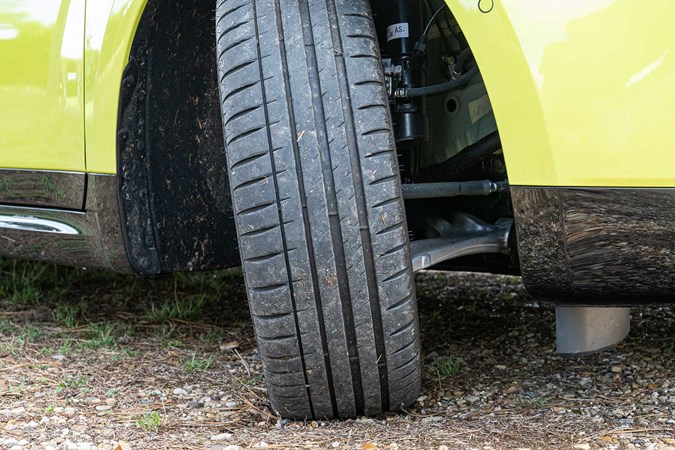
Perhaps the party piece of the Honda’s technical specification is its extraordinarily tight turning circle. Because there is no engine under the bonnet or driveshafts on the front wheels (the e is rear-wheel drive), they can turn to an incredibly acute angle. Just look at the photo above: it’s like a London taxi and means you can manoeuvre into the tightest spaces in the car park, or pull a compact U-turn. I love this feature: it makes town driving so much easier.
In short, we really rate the way the Honda e drives. It has a mature sophistication to it that complements the high-tech interior. It’s especially at home in urban environments, but is just as comfortable on a fast A-road or motorway run. The thing is, driving it on longer inter-city journeys brings a totally different challenge: the paucity of range from that small battery.
We’ll talk about the Honda’s electric car creds, charging it up, costs and the all-important electric range in our next update. Stay tuned.
Update 5: EV charging and running costs – how much does the Honda e cost to run?
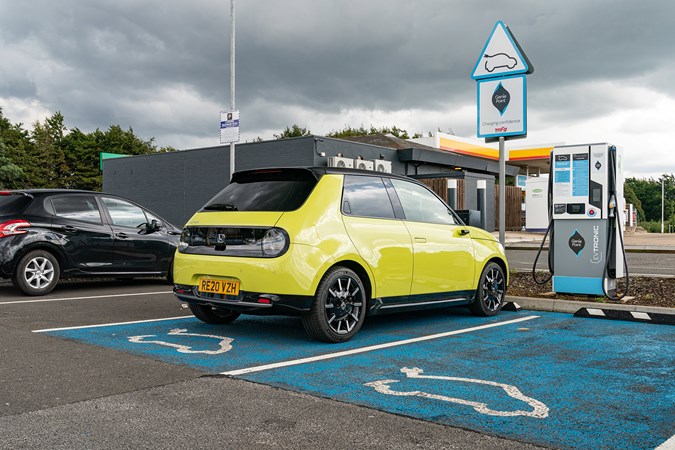
Plugging in, charging up and how the Honda e compares as an electric car
Life with the Honda e is pretty straightforward. I am lucky – it’s not my first EV, and I have plenty of experience of living with electric cars. So I’m used to the idea of plugging in every night, I’ve experienced range anxiety before and I have a charging point at home.
The main challenge with this car is the size of its battery: the 36kWh capacity is among the smallest of any EV on sale today, and ultimately it restricts the range of how far the e can drive on one charge. Honda claims 125 miles on the official WLTP test cycle, but like with old-fashioned miles-per-gallon (mpg) figures for petrol and diesel cars, we’re rarely seeing that in real life.
The Honda arrived in the summer, when the range showed at somewhere between 100-110 miles when fully charged. We have never seen the meter show the full 125 miles, however. Be warned that all electric cars struggle in colder weather and in the chilly winter months we would more normally see a range of as little as 80 miles, maybe even just under.
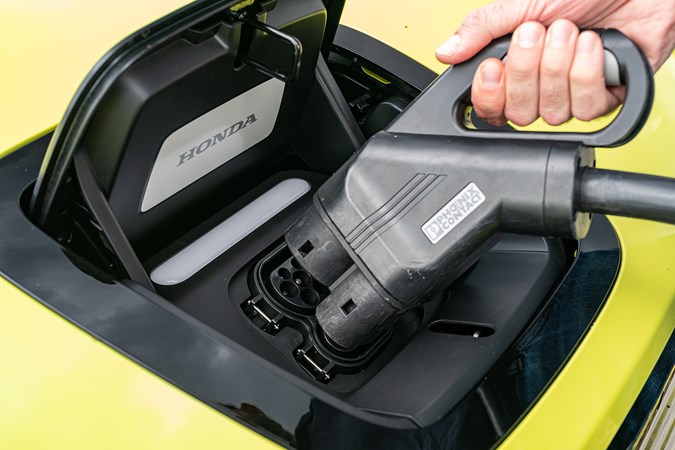
This creates a challenge in day-to-day driving. It’s been imperative to start every day with 100% charge showing – on the occasions I forgot to charge up overnight, I’d struggle even to do two school runs in a day without gnawing my fingernails as the range plummeted. In many ways, the Honda e came into its own in lockdown Britain; it’s perfect for local shopping trips and essential drives – but struggles on longer journeys, holidays and airport runs.
Even driving from one end of Cambridgeshire to the other to visit my mother was not possible without stopping to charge en route. The Honda can be fast-charged easily and accepts up to 100kW DC meaning you can top up at the quickest sites in just half an hour. But don’t forget the e’s battery size holds it back, compared with the longer-range electric Teslas, Audis and Mercedes-Benz models that are proliferating.
How much does the Honda e cost to run? The trip computer records an average electricity consumption hovering somewhere between 2.7 and 3.2 miles per kilowatt hour (kWh), depending on usage and temperature. Clearly, we want that figure to be as high as possible for maximum efficiency and range. Drive like a saint on a warm day around town, tickle the accelerator and coast wherever possible, and you can just match the 3.6 miles per kWh claimed economy.
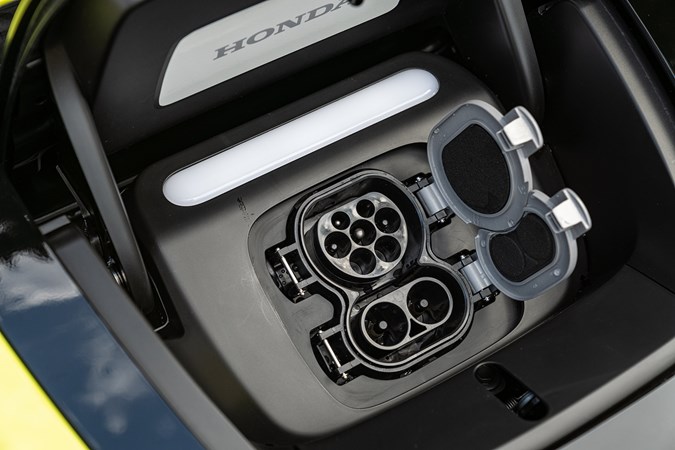
Quick man maths uses my domestic electricity tariff – currently 20.3p per kWh day rate (must shop around!) – to calculate that a full charge costs in the region of £7.30. Which is pretty remarkable, compared with a typical supermini of the same size. The Parkers Miles Per Pound (MPP) calculator reckons the e will travel between 12-14 miles per pound, compared with 8-9 MPP for an equivalent Ford Fiesta 1.0T EcoBoost (100ps) petrol hatchback, whose 42-litre tank would cost £49.77 to brim at January 2021 pump prices.
So it’s costing me buttons to charge up, I’m enjoying zero annual road tax and were I running it as a company car, I would have an extremely favourable benefit-in-kind rate. I just have to remember to charge up every night and limit my expectations of driving it long distances. It’s peerless as a local runaround – and that has suited me just fine in lockdown Britain.
Browse used electric cars for sale
Update 6: our Honda e long-term test conclusion and verdict
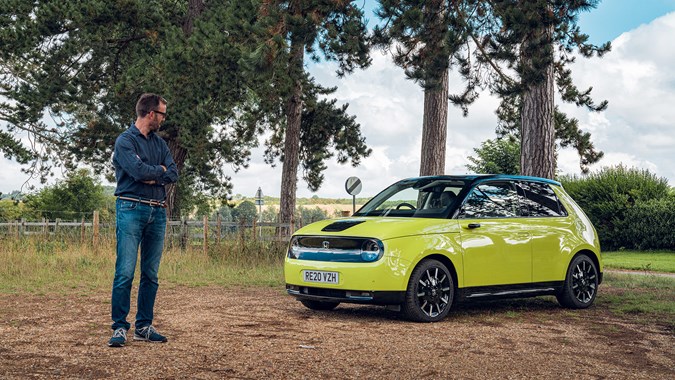
One of the most interesting electric cars on sale today: the Honda e is how we imagine a baby Tesla would be – but with a much shorter range…
We’ve spent half a year in Honda’s battery baby and our verdict is in. This is a distinctive electric car and one that’ll engage your heart as well as your head. Anyone who warns that EVs are just bland white-goods-on-wheels would be advised to have a go in the Honda e. It is anything but dull.
There’s a sense of wanton fun about its design and features: it’s a feelgood car and its cute style, eye-grabbing cabin and robust quality raised a smile every time we slipped behind the wheel, selected Drive and pulled away without anything so old-fashioned as touching a key or a start button. It’s resolutely modern.
As you’ll see from the updates above, it is not without its faults. This is a small vehicle and boot space is as tiny as you’d expect on a city car. We wish it remembered your choice of regenerative braking mode (we had to re-select it every single time, to add more ‘engine braking’ for one-pedal driving to top up the battery under deceleration) and the smartphone app to arrange remote heating and trip computer functions is hopelessly slow to connect.
We suffered one small blip when the 12-volt battery failed in winter. The car wouldn’t start and we learned that you can jump-start an electric car. The small 12v item was replaced under warranty by Marshall Honda in Peterborough, whose service, friendliness and seamless Covid-19 regulations made the dealer experience a doddle. We’d count the 12v under-bonnet battery as a consumable item and our faith in Honda reliability is unshaken.
But these minor shortcomings were dwarfed by the car’s tiny range. The small battery severely restricted the Honda e’s appeal for us. If you live in a city centre and never do more than a few dozen miles, you’ll love it. Because we live in the countryside and often do longer journeys, we had to rely on the UK’s shaky-but-improving public charging infrastructure more than we’d like.
If Honda fitted a battery capacity closer to 50kWh, like on the Peugeot e-208 with its 217-mile range, the e would be just about perfect. Here’s hoping they may address this in future updates.



